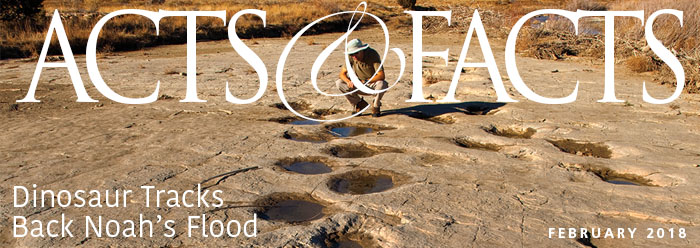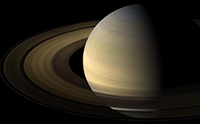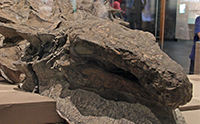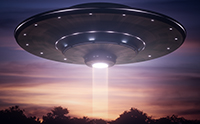Archive of Articles
Instrument data from the Cassini space probe have convinced planetary scientists that Saturn’s rings can be no more than a few hundred million years old.
[abstract_edit] =>
Instrument data from the Cassini space probe have convinced planetary scientists that Saturn’s rings can be no more than a few hundred million years old.
[stage] =>[stage_edit] =>
[body] =>
Data obtained by an instrument aboard the Cassini space probe have convinced planetary scientists that Saturn’s rings can be no more than a few hundred million years old.1 These new data confirmed some researchers’ previous suspicions. For instance, a previous ICR news article described how numerous planetary features within our solar system—including Saturn’s brilliant rings—look “young,” even to secular scientists.2
Numerous planetary features within our solar system—including Saturn’s brilliant rings—look “young,” even to secular scientists.
One of these features is the cleanness of Saturn’s rings. Secular scientists claim that the solar system is around 4.5 billion years old, so if Saturn’s rings were indeed that old, then they should have experienced billions of years’ worth of bombardment by micrometeorites. This would have blackened the icy ring particles, giving them a dark and sooty appearance.
The data obtained from Cassini’s Cosmic Dust Analyzer (CDA) allowed planetary scientists to measure the rate of micrometeorite bombardment:
The flux [of micrometeorite dust], about 10 times higher than estimates from before the Cassini mission, suggest a ring age of between 150 million and 300 million years, or even younger. “Our measurement is the most direct way you can measure it,” [space physicist Sascha] Kempf adds. “There’s not much you can do about it. It has to be young.”1
Note that the rings could be “even younger” than 150 million years. Could the rings be as young as 6,000 years, as implied by the Bible’s historical data? Of course they could, since the 150-300 million year estimate is an upper limit on the age of the rings.
Could Saturn's rings be as young as 6,000 years, as implied by the Bible’s historical data? Of course they could!
Since secular scientists have been forced to concede that the rings are young, they must somehow explain how the rings could have been formed in the relatively recent past, something which is extremely difficult. As noted by Jeff Cuzzi, an expert on Saturn’s rings, “Part of the reluctance for everyone to leap off this bridge into the unknown is we haven’t had any kind of feasible explanation [for how the rings could form recently].”1 Right now, secular scientists can only offer speculative, hand-waving explanations like these:
It was then that some sort of catastrophe befell the gas giant [Saturn]. Perhaps a stray comet or asteroid struck an icy moon, tossing its remnants into orbit. Or maybe the orbits of Saturn’s moons somehow shifted, and the resulting gravitational tug-of-war pulled a moon apart.1 (emphasis added)
As a systems administrator and a team leader on the Cassini project, creation scientist David Coppedge was able to occasionally interact with planetary scientists at the Jet Propulsion Laboratory (JPL). He recounts,
It was clear to me that nothing would dislodge their belief in billions of years, but there was a subtext that it would be very troubling to them if the rings turned out to be young. These quotes [from reference 1] show that to be the case: they are flummoxed and dumbfounded by the evidence. They have no explanation, and they admit it.3
It should be noted in passing that Coppedge was demoted and eventually fired from his position at JPL in an appalling example of “viewpoint discrimination.” Coppedge’s “crimes” were that he privately shared “intelligent design” materials with his colleagues, and that he supported California’s Proposition 8 opposing homosexual marriage.4,5 Although Coppedge was apparently punished for sharing his own personal views, he recounts that his co-workers were allowed to freely express their personal beliefs with impunity.5 In spite of this blatant double standard, Coppedge lost his anti-discrimination lawsuit against JPL; the judge ruled against him without explanation.6
In spite of this injustice, Coppedge played a part in helping make the Cassini project possible, and the result is still more data confirming the youthfulness of our solar system.
References
- Voosen, P. Saturn’s rings are solar system newcomers. Science. 358 (6370): 1513-1514.
- Hebert, J. Youthful Solar System Bodies Puzzle Evolutionary Scientists. Creation Science Update. Posted on ICR.org February 13, 2013, accessed January 3, 2018.
- Coppedge, D. F. It's Official: Saturn's Rings Are Young. Creation Evolution Headlines. Posted on crev.info January 3, 2018, accessed January 3, 2018.
- Klinghoffer, D. NASA Versus David Coppedge: Most Reprehensible Case of Anti-Intelligent Design Persecution Yet? Evolution News and Science Today. Posted on evolutionnews.org December 19, 2016, accessed January 3, 2018.
- Coppedge, D. F. Wheel of Fortune: The Liberal Culture of Shunning. Footprints of David Coppedge. Posted on davidcoppedge.com October 11, 2017, accessed January 4, 2018.
- Lee, S. After a fiery trial. World Magazine. Posted on wng.org May 28, 2016, accessed January 4, 2018.
*Jake Hebert is Research Associate at the Institute for Creation Research and earned his Ph.D. in physics from the University of Texas at Dallas.
Stage Image Credit: Copyright © 2017. NASA. Used in accordance with federal copyright (fair use doctrine) law. Usage by ICR does not imply endorsement of copyright holder.
Article posted on January 8, 2018.
[body_edit] =>Data obtained by an instrument aboard the Cassini space probe have convinced planetary scientists that Saturn’s rings can be no more than a few hundred million years old.1 These new data confirmed some researchers’ previous suspicions. For instance, a previous ICR news article described how numerous planetary features within our solar system—including Saturn’s brilliant rings—look “young,” even to secular scientists.2
Numerous planetary features within our solar system—including Saturn’s brilliant rings—look “young,” even to secular scientists.
One of these features is the cleanness of Saturn’s rings. Secular scientists claim that the solar system is around 4.5 billion years old, so if Saturn’s rings were indeed that old, then they should have experienced billions of years’ worth of bombardment by micrometeorites. This would have blackened the icy ring particles, giving them a dark and sooty appearance.
The data obtained from Cassini’s Cosmic Dust Analyzer (CDA) allowed planetary scientists to measure the rate of micrometeorite bombardment:
The flux [of micrometeorite dust], about 10 times higher than estimates from before the Cassini mission, suggest a ring age of between 150 million and 300 million years, or even younger. “Our measurement is the most direct way you can measure it,” [space physicist Sascha] Kempf adds. “There’s not much you can do about it. It has to be young.”1
Note that the rings could be “even younger” than 150 million years. Could the rings be as young as 6,000 years, as implied by the Bible’s historical data? Of course they could, since the 150-300 million year estimate is an upper limit on the age of the rings.
Could Saturn's rings be as young as 6,000 years, as implied by the Bible’s historical data? Of course they could!
Since secular scientists have been forced to concede that the rings are young, they must somehow explain how the rings could have been formed in the relatively recent past, something which is extremely difficult. As noted by Jeff Cuzzi, an expert on Saturn’s rings, “Part of the reluctance for everyone to leap off this bridge into the unknown is we haven’t had any kind of feasible explanation [for how the rings could form recently].”1 Right now, secular scientists can only offer speculative, hand-waving explanations like these:
It was then that some sort of catastrophe befell the gas giant [Saturn]. Perhaps a stray comet or asteroid struck an icy moon, tossing its remnants into orbit. Or maybe the orbits of Saturn’s moons somehow shifted, and the resulting gravitational tug-of-war pulled a moon apart.1 (emphasis added)
As a systems administrator and a team leader on the Cassini project, creation scientist David Coppedge was able to occasionally interact with planetary scientists at the Jet Propulsion Laboratory (JPL). He recounts,
It was clear to me that nothing would dislodge their belief in billions of years, but there was a subtext that it would be very troubling to them if the rings turned out to be young. These quotes [from reference 1] show that to be the case: they are flummoxed and dumbfounded by the evidence. They have no explanation, and they admit it.3
It should be noted in passing that Coppedge was demoted and eventually fired from his position at JPL in an appalling example of “viewpoint discrimination.” Coppedge’s “crimes” were that he privately shared “intelligent design” materials with his colleagues, and that he supported California’s Proposition 8 opposing homosexual marriage.4,5 Although Coppedge was apparently punished for sharing his own personal views, he recounts that his co-workers were allowed to freely express their personal beliefs with impunity.5 In spite of this blatant double standard, Coppedge lost his anti-discrimination lawsuit against JPL; the judge ruled against him without explanation.6
In spite of this injustice, Coppedge played a part in helping make the Cassini project possible, and the result is still more data confirming the youthfulness of our solar system.
References
- Voosen, P. Saturn’s rings are solar system newcomers. Science. 358 (6370): 1513-1514.
- Hebert, J. Youthful Solar System Bodies Puzzle Evolutionary Scientists. Creation Science Update. Posted on ICR.org February 13, 2013, accessed January 3, 2018.
- Coppedge, D. F. It's Official: Saturn's Rings Are Young. Creation Evolution Headlines. Posted on crev.info January 3, 2018, accessed January 3, 2018.
- Klinghoffer, D. NASA Versus David Coppedge: Most Reprehensible Case of Anti-Intelligent Design Persecution Yet? Evolution News and Science Today. Posted on evolutionnews.org December 19, 2016, accessed January 3, 2018.
- Coppedge, D. F. Wheel of Fortune: The Liberal Culture of Shunning. Footprints of David Coppedge. Posted on davidcoppedge.com October 11, 2017, accessed January 4, 2018.
- Lee, S. After a fiery trial. World Magazine. Posted on wng.org May 28, 2016, accessed January 4, 2018.
*Jake Hebert is Research Associate at the Institute for Creation Research and earned his Ph.D. in physics from the University of Texas at Dallas.
Stage Image Credit: Copyright © 2017. NASA. Used in accordance with federal copyright (fair use doctrine) law. Usage by ICR does not imply endorsement of copyright holder.
Article posted on January 8, 2018.
[typeID] => 9 [visible] => t [pdf] => [publishURL] => secular-scientists-dumbfounded-by-saturns [publishDate] => 0000-00-00 [authorAsterisk] => t [domainID] => 1 [publication] => [volume] => [issue] => [page] => [author] => Jake Hebert, Ph.D. ) -->
Some are concerned that global warming will melt the polar ice caps and lead to a rise in global sea level. Is this really happening?
[abstract_edit] =>
Some are concerned that global warming will melt the polar ice caps and lead to a rise in global sea level. Is this really happening?
[stage] =>[stage_edit] =>
[body] =>
Some are concerned that global warming will cause the polar ice caps to melt, leading to an increase in global sea level. If such a rise in sea level occurred slowly, coastal peoples would have time to adjust to the change. But many are concerned that sea level could rise rapidly, leading to a humanitarian catastrophe.
Although some scientists claim that satellite and tide-gauge data confirm a rapidly rising sea level, others are skeptical. In fact, two Australian scientists, Dr. Albert Parker and Dr. Clifford Ollier, have recently charged that Indian Ocean sea-level data for the last 140 years were manipulated to show a dramatic rise in sea level, even though the raw data showed that sea level had remained steady, or even dropped.1,2,3
Indian Ocean sea-level data for the last 140 years were manipulated to show a dramatic rise in sea level, even though the raw data showed that sea level had remained steady, or even dropped.
Concerns over sea level rise are also being stoked by the way secular scientists interpret chemical wiggles within deep-seafloor sediments. These chemical wiggles (called oxygen isotope ratios) are thought to serve as “proxy” or “stand in” values for global ice volume: higher oxygen isotope ratios (denoted by the symbol δ18O) are thought to indicate ice ages, and lower values are thought to correspond to warmer “interglacial” periods.
When water freezes to form ice, less of Earth’s total water is available to remain liquid. Since the total mass of water on Earth remains essentially constant, an increase in global ice volume should result in a decrease in global mean sea level, and vice versa. This means that δ18O values can presumably indicate past global sea levels.
Most secular scientists assume the validity of the astronomical (or Milankovitch) ice age theory, which posits that ice ages are caused by slow, gradual changes in Earth’s orbital and rotational motions, which in turn are thought to affect the way sunlight is distributed on the Earth. Then they use astronomical calculations to infer times in the supposed prehistoric past when these sunlight variations are thought to have resulted in ice ages, and then these ages are assigned to the peak δ18O values.
Then they use these ages to calculate past rates of sea level rise. These calculated rates have led secular scientists to worry about possible future catastrophic global flooding.
Oceanographer Wolfgang Berger asked:
Just when can we expect to see a rapid rise of sea level, ten times higher than the present values of a few millimeters per year? We do not know. All we can say, from experience with the many millennia of the ice-age records in the deep sea, is that once melting starts, it stimulates further melting for centuries. Deglaciation keeps going once begun in earnest: a great example of the dilemma of the sorcerer’s apprentice.4
What Berger is calling “experience” is just a Milankovitch interpretation of the seafloor sediment data. But if the Milankovitch theory is wrong, then the ages assigned to the seafloor sediments are completely fictitious, as are the calculated rates of past sea level rise!
If the Milankovitch theory is wrong, then the ages assigned to the seafloor sediments are completely fictitious, as are the calculated rates of past sea level rise!
Despite its popularity, there are many problems with the astronomical theory.5 Moreover, recent ICR research has raised serious doubts about a key argument for the theory presented in a well-known paper titled “The Pacemaker of the Ice Ages.”6 The argument is so important that last year the journals Science and Nature both ran articles commemorating the paper’s 40th anniversary.7,8 More than a year later, secular scientists have yet to respond to this new research. Of course, they would probably claim that there is additional evidence for the theory, so that the theory is confirmed even without the Pacemaker paper’s validity. But if the Pacemaker paper is not essential to the argument for the Milankovitch theory, then why are supporters of the theory so reluctant to candidly acknowledge the paper’s problems?
Since the argument for a rapidly rising sea level inferred from seafloor sediments is logically invalid, then evidence for such a claim, if it exists, can only come from satellite and tide-gauge data. Given the history of data manipulation in this field,9 including these recent allegations regarding Indian Ocean data, such claims should be heavily scrutinized before being accepted as valid.
References
- Parker, A. and C. D. Ollier. 2017. Is the Sea Level Stable at Aden, Yemen? Earth Systems and Environment. 1: 18. doi.org/10.1007/s41748-017-0020-z.
- Richard, K. ‘Adjustments’ to Create Spurious Sea Level Rise Have Now Infected the PSMSL Tide Gauge Data. Posted at notrickszone.com December 4, 2017, accessed December 12, 2017.
- Delingpole, J. 2017. Tidalgate: Climate Alarmists Caught Faking Sea Level Rise. Posted at breitbart.com on December 6, 2017, accessed December 12, 2017.
- Berger, W. H. 2012. Milankovitch Theory—Hits and Misses. Scripps Institution of Oceanography, University of California San Diego, La Jolla, California, 16. Emphasis added.
- Oard, M. J. 2007. Astronomical troubles for the astronomical hypothesis of ice ages. Journal of Creation. 21 (3): 19-23.
- Hebert, J. 2016. Revisiting an Iconic Argument for Milankovitch Climate Forcing: Should the "Pacemaker of the Ice Ages" Paper Be Retracted? Part 3. Answers Reserach Journal. 9:229-255.
- Hodell, D. A. 2016. The smoking gun of the ice ages. Science. 354 (6317): 1235-1236.
- Maslin, M. 2016. Forty years of linking orbits to ice ages. Nature. 540 (7632): 208-210.
- McIntyre, S. and R. McKitrick. 2005. Hockey sticks, principal components, and spurious significance. Geophysical Research Letters. 32, L03710.
*Dr. Jake Hebert is Research Associate at the Institute for Creation Research and earned his Ph.D. in physics from the University of Texas at Dallas.
Article posted on January 4, 2018.
[body_edit] =>Some are concerned that global warming will cause the polar ice caps to melt, leading to an increase in global sea level. If such a rise in sea level occurred slowly, coastal peoples would have time to adjust to the change. But many are concerned that sea level could rise rapidly, leading to a humanitarian catastrophe.
Although some scientists claim that satellite and tide-gauge data confirm a rapidly rising sea level, others are skeptical. In fact, two Australian scientists, Dr. Albert Parker and Dr. Clifford Ollier, have recently charged that Indian Ocean sea-level data for the last 140 years were manipulated to show a dramatic rise in sea level, even though the raw data showed that sea level had remained steady, or even dropped.1,2,3
Indian Ocean sea-level data for the last 140 years were manipulated to show a dramatic rise in sea level, even though the raw data showed that sea level had remained steady, or even dropped.
Concerns over sea level rise are also being stoked by the way secular scientists interpret chemical wiggles within deep-seafloor sediments. These chemical wiggles (called oxygen isotope ratios) are thought to serve as “proxy” or “stand in” values for global ice volume: higher oxygen isotope ratios (denoted by the symbol δ18O) are thought to indicate ice ages, and lower values are thought to correspond to warmer “interglacial” periods.
When water freezes to form ice, less of Earth’s total water is available to remain liquid. Since the total mass of water on Earth remains essentially constant, an increase in global ice volume should result in a decrease in global mean sea level, and vice versa. This means that δ18O values can presumably indicate past global sea levels.
Most secular scientists assume the validity of the astronomical (or Milankovitch) ice age theory, which posits that ice ages are caused by slow, gradual changes in Earth’s orbital and rotational motions, which in turn are thought to affect the way sunlight is distributed on the Earth. Then they use astronomical calculations to infer times in the supposed prehistoric past when these sunlight variations are thought to have resulted in ice ages, and then these ages are assigned to the peak δ18O values.
Then they use these ages to calculate past rates of sea level rise. These calculated rates have led secular scientists to worry about possible future catastrophic global flooding.
Oceanographer Wolfgang Berger asked:
Just when can we expect to see a rapid rise of sea level, ten times higher than the present values of a few millimeters per year? We do not know. All we can say, from experience with the many millennia of the ice-age records in the deep sea, is that once melting starts, it stimulates further melting for centuries. Deglaciation keeps going once begun in earnest: a great example of the dilemma of the sorcerer’s apprentice.4
What Berger is calling “experience” is just a Milankovitch interpretation of the seafloor sediment data. But if the Milankovitch theory is wrong, then the ages assigned to the seafloor sediments are completely fictitious, as are the calculated rates of past sea level rise!
If the Milankovitch theory is wrong, then the ages assigned to the seafloor sediments are completely fictitious, as are the calculated rates of past sea level rise!
Despite its popularity, there are many problems with the astronomical theory.5 Moreover, recent ICR research has raised serious doubts about a key argument for the theory presented in a well-known paper titled “The Pacemaker of the Ice Ages.”6 The argument is so important that last year the journals Science and Nature both ran articles commemorating the paper’s 40th anniversary.7,8 More than a year later, secular scientists have yet to respond to this new research. Of course, they would probably claim that there is additional evidence for the theory, so that the theory is confirmed even without the Pacemaker paper’s validity. But if the Pacemaker paper is not essential to the argument for the Milankovitch theory, then why are supporters of the theory so reluctant to candidly acknowledge the paper’s problems?
Since the argument for a rapidly rising sea level inferred from seafloor sediments is logically invalid, then evidence for such a claim, if it exists, can only come from satellite and tide-gauge data. Given the history of data manipulation in this field,9 including these recent allegations regarding Indian Ocean data, such claims should be heavily scrutinized before being accepted as valid.
References
- Parker, A. and C. D. Ollier. 2017. Is the Sea Level Stable at Aden, Yemen? Earth Systems and Environment. 1: 18. doi.org/10.1007/s41748-017-0020-z.
- Richard, K. ‘Adjustments’ to Create Spurious Sea Level Rise Have Now Infected the PSMSL Tide Gauge Data. Posted at notrickszone.com December 4, 2017, accessed December 12, 2017.
- Delingpole, J. 2017. Tidalgate: Climate Alarmists Caught Faking Sea Level Rise. Posted at breitbart.com on December 6, 2017, accessed December 12, 2017.
- Berger, W. H. 2012. Milankovitch Theory—Hits and Misses. Scripps Institution of Oceanography, University of California San Diego, La Jolla, California, 16. Emphasis added.
- Oard, M. J. 2007. Astronomical troubles for the astronomical hypothesis of ice ages. Journal of Creation. 21 (3): 19-23.
- Hebert, J. 2016. Revisiting an Iconic Argument for Milankovitch Climate Forcing: Should the "Pacemaker of the Ice Ages" Paper Be Retracted? Part 3. Answers Reserach Journal. 9:229-255.
- Hodell, D. A. 2016. The smoking gun of the ice ages. Science. 354 (6317): 1235-1236.
- Maslin, M. 2016. Forty years of linking orbits to ice ages. Nature. 540 (7632): 208-210.
- McIntyre, S. and R. McKitrick. 2005. Hockey sticks, principal components, and spurious significance. Geophysical Research Letters. 32, L03710.
*Dr. Jake Hebert is Research Associate at the Institute for Creation Research and earned his Ph.D. in physics from the University of Texas at Dallas.
Article posted on January 4, 2018.
[typeID] => 9 [visible] => t [pdf] => [publishURL] => global-sea-level-rising [publishDate] => 0000-00-00 [authorAsterisk] => t [domainID] => 1 [publication] => [volume] => [issue] => [page] => [author] => Jake Hebert, Ph.D. ) -->
The Institute for Creation Research has monitored the steady flow of fresh-looking fossils for over a decade. 2017 provided additional discoveries of biochemical variety that includes proteins, pigments, and even a pineal gland. These present a real challenge to the millions-of-years age assignments for these fossils, since best-case scenarios predict that biochemicals fizzle out in less than one million years.
[abstract_edit] =>
The Institute for Creation Research has monitored the steady flow of fresh-looking fossils for over a decade. 2017 provided additional discoveries of biochemical variety that includes proteins, pigments, and even a pineal gland. These present a real challenge to the millions-of-years age assignments for these fossils, since best-case scenarios predict that biochemicals fizzle out in less than one million years.
[stage] =>[stage_edit] =>
[body] =>
The Institute for Creation Research has monitored the steady flow of fresh-looking fossils for over a decade. The year 2017 was impressive with its discoveries of biochemical variety that includes proteins, pigments, and even a pineal gland. Each such discovery presents a real challenge to the millions-of-years age assignments for these fossils, since best-case scenarios predict that biochemicals fizzle out in less than one million years.
Each discovery presents a real challenge to millions-of-years age assignments for these fossils, since best-case scenarios predict that biochemicals fizzle out in less than 1 million years.
ICR’s Creation Science Update highlighted these 2017 discoveries of fresh-looking fossils:
• The University of Wisconsin-Milwaukee researchers recovered amino acids—protein’s chemical building blocks—from preserved cells of a fossilized once-tropical tree from an Antarctic rock deemed 280 million years old. How can these amino acids still be intact?1
• Gerald Mayr from the Senckenberg Research Institute announced this year the discovery of the world’s oldest lipid. Germany’s Messel Shale, regarded as 48 million years old, harbored an ancient bird’s oil-filled preening gland. And the gland had some of the original oil still in it, not shale.2
• An international team described in the journal Scientific Reports fresh-looking pigments darkening the crusty skin of a fossil turtle.2 Nobody has explained what could possibly have kept bacteria from consuming the carbon-rich pigment for 54 million supposed years.
• German and American scientists described turquoise-colored Cretaceous egg pigments from Chinese oviraptor fossils.3
• Chinese researchers clearly photographed the insides of original bird bone that evolutionists insist was buried 120 million years ago. It had delicate internal canals and fine layers instead of the expected mud-borne minerals inside. Given Earth’s relentless degrading processes, including incessant water movement underground, who would expect a buried bone to persist for even a tenth of that imagined time?
• News outlets hailed a fabulous 2017 fossil the world’s best-preserved dinosaur. Later analyses revealed original pigments still inside its naturally mummified scaly skin.4 Such fresh features don’t fit its 112-125 million-year age assignment.
• Sweden’s Lund University reported fresh waxy cuticles coating supposedly 200-million year-old ginkgo leaves. Low-impact scanning techniques stunned scientists who did not expect them to be “full of organic molecules.”5
Finally, famed amber researcher George Poinar described mammalian blood cells still intact inside a tick trapped in Dominican amber. Amber has no magical preservation properties that would suspend the standard laws of chemical decay for millions of years.6
One more report confirmed collagen protein sequence from a supposedly 80-million-year-old Hadrosaur femur excavated in Montana. Published in the prestigious Journal of Proteome Research, the results again revealed the presence of hydroxyproline, an amino acid unique to collagen.7 Some fossil experts who still disbelieve fossil proteins attribute the discoveries to modern bacteria. But bacteria can’t make hydroxyproline—or collagen for that matter.
We predict 2018 will add more discoveries to the long list of biochemicals that can’t be millions of years old.
The story that fossils are too old to still have short-lived chemicals crumbles under the weight of so many fine discoveries. We predict 2018 will add more discoveries to the long list of biochemicals that can’t be millions of years old.
References
- Clarey, T. Fossil Trees in Antarctica Preserve Ancient Proteins. Creation Science Update. Posted on ICR.org December 11, 2017, accessed December 15, 2017.
- Thomas, B. Ancient Animal Biochemicals Again. Creation Science Update. Posted on ICR.org December 7, 2017, accessed December 15, 2017.
- Wiemann, J. et al. Dinosaur origin of egg color: oviraptors laid blue-green eggs. PeerJ. 5:e3706. See also ICR’s original announcement of this fossil: Thomas, B. Colorful Dinosaur Eggs Challenge Deep Time. Creation Science Update. Posted on ICR.org June 11, 2015, accessed December 15, 2017
- Thomas, B. Spectacular Dinosaur Has Skin, Horn, Pigments. Creation Science Update. Posted on ICR.org August 28, 2017, accessed December 15, 2017.
- See references in Thomas, B. Fossil Plants Contain Original Molecules. Creation Science Update. Posted on ICR.org August 3, 2017, accessed December 15, 2017.
- Thomas, B. 2010. Amber Jewelry: A Conversation Piece for Creation Evidence. Acts & Facts. 39 (9): 17.
- Schroeter, E.R. et al. 2017. Expansion for the Brachylophosaurus canadensis Collagen I Sequence and Additional Evidence of the Preservation of Cretaceous Protein. Journal of Proteome Research. 16 (2): 920-932.
*Brian Thomas is Science Writer at the Institute for Creation Research and earned his M.S. in biotechnology from Stephen F. Austin State University.
Stage image credit: Used in accordance with federal copyright (fair use doctrine) law. Usage by ICR does not imply endorsement of copyright holders.
Article posted on December 28, 2017.
[body_edit] =>The Institute for Creation Research has monitored the steady flow of fresh-looking fossils for over a decade. The year 2017 was impressive with its discoveries of biochemical variety that includes proteins, pigments, and even a pineal gland. Each such discovery presents a real challenge to the millions-of-years age assignments for these fossils, since best-case scenarios predict that biochemicals fizzle out in less than one million years.
Each discovery presents a real challenge to millions-of-years age assignments for these fossils, since best-case scenarios predict that biochemicals fizzle out in less than 1 million years.
ICR’s Creation Science Update highlighted these 2017 discoveries of fresh-looking fossils:
• The University of Wisconsin-Milwaukee researchers recovered amino acids—protein’s chemical building blocks—from preserved cells of a fossilized once-tropical tree from an Antarctic rock deemed 280 million years old. How can these amino acids still be intact?1
• Gerald Mayr from the Senckenberg Research Institute announced this year the discovery of the world’s oldest lipid. Germany’s Messel Shale, regarded as 48 million years old, harbored an ancient bird’s oil-filled preening gland. And the gland had some of the original oil still in it, not shale.2
• An international team described in the journal Scientific Reports fresh-looking pigments darkening the crusty skin of a fossil turtle.2 Nobody has explained what could possibly have kept bacteria from consuming the carbon-rich pigment for 54 million supposed years.
• German and American scientists described turquoise-colored Cretaceous egg pigments from Chinese oviraptor fossils.3
• Chinese researchers clearly photographed the insides of original bird bone that evolutionists insist was buried 120 million years ago. It had delicate internal canals and fine layers instead of the expected mud-borne minerals inside. Given Earth’s relentless degrading processes, including incessant water movement underground, who would expect a buried bone to persist for even a tenth of that imagined time?
• News outlets hailed a fabulous 2017 fossil the world’s best-preserved dinosaur. Later analyses revealed original pigments still inside its naturally mummified scaly skin.4 Such fresh features don’t fit its 112-125 million-year age assignment.
• Sweden’s Lund University reported fresh waxy cuticles coating supposedly 200-million year-old ginkgo leaves. Low-impact scanning techniques stunned scientists who did not expect them to be “full of organic molecules.”5
Finally, famed amber researcher George Poinar described mammalian blood cells still intact inside a tick trapped in Dominican amber. Amber has no magical preservation properties that would suspend the standard laws of chemical decay for millions of years.6
One more report confirmed collagen protein sequence from a supposedly 80-million-year-old Hadrosaur femur excavated in Montana. Published in the prestigious Journal of Proteome Research, the results again revealed the presence of hydroxyproline, an amino acid unique to collagen.7 Some fossil experts who still disbelieve fossil proteins attribute the discoveries to modern bacteria. But bacteria can’t make hydroxyproline—or collagen for that matter.
We predict 2018 will add more discoveries to the long list of biochemicals that can’t be millions of years old.
The story that fossils are too old to still have short-lived chemicals crumbles under the weight of so many fine discoveries. We predict 2018 will add more discoveries to the long list of biochemicals that can’t be millions of years old.
References
- Clarey, T. Fossil Trees in Antarctica Preserve Ancient Proteins. Creation Science Update. Posted on ICR.org December 11, 2017, accessed December 15, 2017.
- Thomas, B. Ancient Animal Biochemicals Again. Creation Science Update. Posted on ICR.org December 7, 2017, accessed December 15, 2017.
- Wiemann, J. et al. Dinosaur origin of egg color: oviraptors laid blue-green eggs. PeerJ. 5:e3706. See also ICR’s original announcement of this fossil: Thomas, B. Colorful Dinosaur Eggs Challenge Deep Time. Creation Science Update. Posted on ICR.org June 11, 2015, accessed December 15, 2017
- Thomas, B. Spectacular Dinosaur Has Skin, Horn, Pigments. Creation Science Update. Posted on ICR.org August 28, 2017, accessed December 15, 2017.
- See references in Thomas, B. Fossil Plants Contain Original Molecules. Creation Science Update. Posted on ICR.org August 3, 2017, accessed December 15, 2017.
- Thomas, B. 2010. Amber Jewelry: A Conversation Piece for Creation Evidence. Acts & Facts. 39 (9): 17.
- Schroeter, E.R. et al. 2017. Expansion for the Brachylophosaurus canadensis Collagen I Sequence and Additional Evidence of the Preservation of Cretaceous Protein. Journal of Proteome Research. 16 (2): 920-932.
*Brian Thomas is Science Writer at the Institute for Creation Research and earned his M.S. in biotechnology from Stephen F. Austin State University.
Stage image credit: Used in accordance with federal copyright (fair use doctrine) law. Usage by ICR does not imply endorsement of copyright holders.
Article posted on December 28, 2017.
[typeID] => 9 [visible] => t [pdf] => [publishURL] => best-2017-fleshy-fossils [publishDate] => 0000-00-00 [authorAsterisk] => t [domainID] => 1 [publication] => [volume] => [issue] => [page] => [author] => Brian Thomas, Ph.D. ) -->
Recent marketing research conducted a 24-country survey about people’s belief in aliens. They released their results just before the next widely anticipated Star Wars installment. How do biblical truths and scientific facts impact humanity’s concept of aliens from outer space?
[abstract_edit] =>
Recent marketing research conducted a 24-country survey about people’s belief in aliens. They released their results just before the next widely anticipated Star Wars installment. How do biblical truths and scientific facts impact humanity’s concept of aliens from outer space?
[stage] =>[stage_edit] =>
[body] =>
Marketing research group Glocalities conducted a 24-country survey about people’s belief in aliens. They released their results just before the next widely anticipated Star Wars installment. How do biblical truths and scientific facts impact humanity’s concept of aliens from outer space?
Reuters news summarized some of the survey results.1 Sixty-one percent of 26,000 respondents said “yes” when asked if they believe in “some form of life on other planets.” That lifeform could mean bacteria or something more intelligent. Forty-seven percent believe “in the existence of intelligent alien civilizations” out there somewhere.
We apparently live in alien-crazed societies. Where is the evidence that has convinced so many of space aliens?
Scripture shows no direct support for E.T.s. In fact, the Bible poses a gospel challenge to the existence of intelligent alien civilizations.
First, Scripture shows no direct support for E.T.s. In fact, the Bible poses a gospel challenge to the existence of intelligent alien civilizations. ICR news wrote in 2011, “Extraterrestrial life would also contradict the Bible’s claim that ‘Christ died once for all’ to pay for the sins of humanity (Hebrews 10:10), since to be fair, He would have to die as many times as there are planets inhabited with intelligent life.”2
Since the Lord Jesus died only once before His resurrection, He could not have gone to die again on alien planets. Therefore, intelligent redeemable E.T.s must not exist.
What about support from science? Even secular researchers have refuted intelligent aliens on the basis of a complete lack of E.T. evidence. Nobody has ever detected a single intelligent signal that came from out there.
What about support from science? Even secular researchers have refuted intelligent aliens on the basis of a complete lack of E.T. evidence.
Plus, they long ago raised a logical argument against aliens called the “Fermi paradox.”3 So many stars and planets populate the universe that even if a tiny fraction were suitable for life, many should populate the universe today if stars and planets have been emerging for billions of years. Instead it’s as silent as sound in space.
It looks like half the world believes in aliens for reasons other than tangible or logical evidence. So, what feature do E.T.s carry that compels so many to accept the concept?
It does fit right in with evolution’s story of a universe where nature, not God, somehow does all the creating.
The Search for Extraterrestrial Intelligence (SETI) Institute is dedicated to the search for space aliens. ICR news quoted from a 2011 SETI website plea that said, “That’s why we’re appealing to you—someone who recognizes that the evolutionary drama that has taken place on our planet may have happened on other worlds”4 But after listening for years the SETI Institute has zero E.T. evidence.
Cultural phenomena like the movie industry and popular evolutionary dramas may propagate widespread belief in space aliens, but so far it has no biblical or scientific legs to stand on.
References
- Deutsch, A. and L. King. Are Earthlings Alone? Half of humans believe in alien life. Reuters. Posted on reuters.com December 7, 2017, accessed December 8, 2017.
- Thomas, B. Another ‘Goldilocks’ Planet Stirs ET Hopes. Creation Science Update. Posted on ICR.org December 16, 2011, accessed December 8, 2017.
- Lisle, J. Are ETs & UFOs Real? In The New Answers Book. Posted on answersingenesis.org December 6, 2007, accessed December 7, 2011. Also, the upcoming movie Alien Intrusion vividly illustrates the Fermi paradox.
- Thomas, B. 2011. SETI Funding Linked to Belief in Evolution. Creation Science Update. Posted on ICR.org May 9, 2011, accessed December 8, 2011.
*Brian Thomas is Science Writer at the Institute for Creation Research and earned his M.S. in biotechnology from Stephen F. Austin State University.
Article posted on December 26, 2017.
[body_edit] =>Marketing research group Glocalities conducted a 24-country survey about people’s belief in aliens. They released their results just before the next widely anticipated Star Wars installment. How do biblical truths and scientific facts impact humanity’s concept of aliens from outer space?
Reuters news summarized some of the survey results.1 Sixty-one percent of 26,000 respondents said “yes” when asked if they believe in “some form of life on other planets.” That lifeform could mean bacteria or something more intelligent. Forty-seven percent believe “in the existence of intelligent alien civilizations” out there somewhere.
We apparently live in alien-crazed societies. Where is the evidence that has convinced so many of space aliens?
Scripture shows no direct support for E.T.s. In fact, the Bible poses a gospel challenge to the existence of intelligent alien civilizations.
First, Scripture shows no direct support for E.T.s. In fact, the Bible poses a gospel challenge to the existence of intelligent alien civilizations. ICR news wrote in 2011, “Extraterrestrial life would also contradict the Bible’s claim that ‘Christ died once for all’ to pay for the sins of humanity (Hebrews 10:10), since to be fair, He would have to die as many times as there are planets inhabited with intelligent life.”2
Since the Lord Jesus died only once before His resurrection, He could not have gone to die again on alien planets. Therefore, intelligent redeemable E.T.s must not exist.
What about support from science? Even secular researchers have refuted intelligent aliens on the basis of a complete lack of E.T. evidence. Nobody has ever detected a single intelligent signal that came from out there.
What about support from science? Even secular researchers have refuted intelligent aliens on the basis of a complete lack of E.T. evidence.
Plus, they long ago raised a logical argument against aliens called the “Fermi paradox.”3 So many stars and planets populate the universe that even if a tiny fraction were suitable for life, many should populate the universe today if stars and planets have been emerging for billions of years. Instead it’s as silent as sound in space.
It looks like half the world believes in aliens for reasons other than tangible or logical evidence. So, what feature do E.T.s carry that compels so many to accept the concept?
It does fit right in with evolution’s story of a universe where nature, not God, somehow does all the creating.
The Search for Extraterrestrial Intelligence (SETI) Institute is dedicated to the search for space aliens. ICR news quoted from a 2011 SETI website plea that said, “That’s why we’re appealing to you—someone who recognizes that the evolutionary drama that has taken place on our planet may have happened on other worlds”4 But after listening for years the SETI Institute has zero E.T. evidence.
Cultural phenomena like the movie industry and popular evolutionary dramas may propagate widespread belief in space aliens, but so far it has no biblical or scientific legs to stand on.
References
- Deutsch, A. and L. King. Are Earthlings Alone? Half of humans believe in alien life. Reuters. Posted on reuters.com December 7, 2017, accessed December 8, 2017.
- Thomas, B. Another ‘Goldilocks’ Planet Stirs ET Hopes. Creation Science Update. Posted on ICR.org December 16, 2011, accessed December 8, 2017.
- Lisle, J. Are ETs & UFOs Real? In The New Answers Book. Posted on answersingenesis.org December 6, 2007, accessed December 7, 2011. Also, the upcoming movie Alien Intrusion vividly illustrates the Fermi paradox.
- Thomas, B. 2011. SETI Funding Linked to Belief in Evolution. Creation Science Update. Posted on ICR.org May 9, 2011, accessed December 8, 2011.
*Brian Thomas is Science Writer at the Institute for Creation Research and earned his M.S. in biotechnology from Stephen F. Austin State University.
Article posted on December 26, 2017.
[typeID] => 9 [visible] => t [pdf] => [publishURL] => poll-half-humanity-believes-aliens [publishDate] => 0000-00-00 [authorAsterisk] => t [domainID] => 1 [publication] => [volume] => [issue] => [page] => [author] => Brian Thomas, Ph.D. ) -->
Spread the word. Become a creation advocate. Join us today.
[abstract_edit] =>
Spread the word. Become a creation advocate. Join us today.
[stage] =>[stage_edit] =>
[body] =>
Hello, friends!
We have a new opportunity to reach people with scientific evidence that confirms the Bible’s accuracy. This is our first time participating in Giving Tuesday—“a global day of giving fueled by the power of social media and collaboration.” Will you partner with us today?
- Pray for the impact of God’s Word on hearts around the world.
- Contribute financially to help us continue this vital mission.
- Spread the word about ICR’s ministry via social media, texting, and email.
Follow us on Facebook, Twitter, Instagram, Pinterest, LinkedIn, and Google+.
Thank you for joining us in this online giving event!
Article posted on November 28, 2017.
[body_edit] =>Hello, friends!
We have a new opportunity to reach people with scientific evidence that confirms the Bible’s accuracy. This is our first time participating in Giving Tuesday—“a global day of giving fueled by the power of social media and collaboration.” Will you partner with us today?
- Pray for the impact of God’s Word on hearts around the world.
- Contribute financially to help us continue this vital mission.
- Spread the word about ICR’s ministry via social media, texting, and email.
Follow us on Facebook, Twitter, Instagram, Pinterest, LinkedIn, and Google+.
Thank you for joining us in this online giving event!
Article posted on November 28, 2017.
[typeID] => 9 [visible] => t [pdf] => [publishURL] => giving-tuesdaybecome-creation-advocate [publishDate] => 0000-00-00 [authorAsterisk] => f [domainID] => 1 [publication] => [volume] => [issue] => [page] => [author] => Staff Writer ) -->

















































